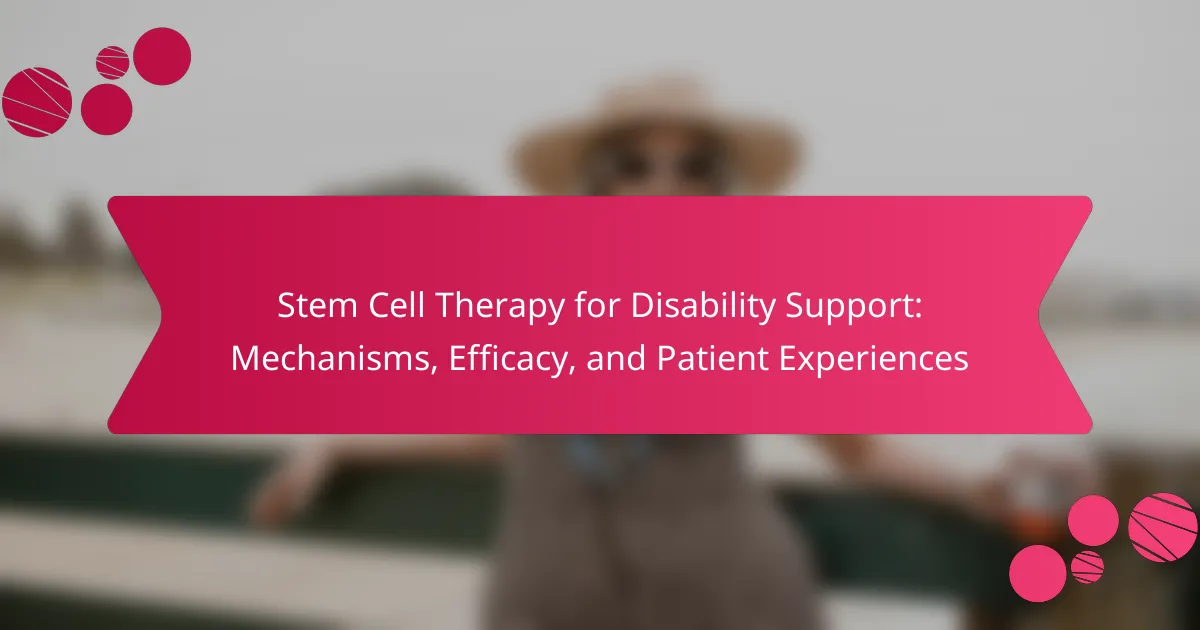Stem cell therapy offers a potential solution for individuals facing disabilities, aiming to enhance mobility and quality of life. This article explores the mechanisms of stem cell therapy, its efficacy supported by clinical evidence, and the personal experiences of patients undergoing treatment. It also addresses the challenges and cultural perspectives surrounding this innovative approach, while highlighting ongoing research aimed at improving recovery outcomes.

What are the key mechanisms of stem cell therapy for disability support?
Stem cell therapy supports disabilities through mechanisms like regeneration, immunomodulation, and differentiation. Regeneration involves repairing damaged tissues, while immunomodulation helps in reducing inflammation. Differentiation allows stem cells to transform into specific cell types, aiding recovery. Clinical evidence shows improved mobility and function in patients, enhancing their quality of life.
How do stem cells differentiate into specialized cells?
Stem cells differentiate into specialized cells through a process influenced by intrinsic and extrinsic factors. These factors include signaling molecules, environmental cues, and cell-to-cell interactions.
During differentiation, stem cells undergo changes in gene expression, leading to the development of specific cell types. For instance, mesenchymal stem cells can become bone, cartilage, or fat cells based on the signals they receive.
This differentiation is crucial in stem cell therapy for disability support, as it allows for the regeneration of damaged tissues. Patient experiences highlight the potential efficacy of these therapies in improving mobility and function.
What role do stem cells play in tissue regeneration?
Stem cells play a crucial role in tissue regeneration by differentiating into various cell types and promoting healing. They can repair damaged tissues, restore function, and reduce disability. Research shows that stem cell therapy enhances recovery in conditions like spinal cord injuries and degenerative diseases. Patient experiences indicate improved mobility and quality of life, highlighting the therapy’s efficacy.
How does the immune response interact with stem cell therapy?
The immune response can significantly influence the outcomes of stem cell therapy. Immune cells may either enhance or hinder the therapeutic effects of stem cells. For instance, they can help in tissue repair or create an inflammatory environment that limits stem cell efficacy. The interaction often depends on the type of stem cells used and the underlying condition being treated. Understanding these dynamics is crucial for improving treatment strategies and patient outcomes in disability support.
What are the delivery methods for stem cell therapy?
Stem cell therapy can be delivered through various methods, including intravenous infusion, direct injection, and local administration. Each method has distinct applications and efficacy depending on the condition being treated.
Intravenous infusion allows for systemic distribution of stem cells, making it suitable for conditions affecting multiple areas. Direct injection targets specific sites, enhancing localized effects. Local administration, such as into the spinal cord, is often used for neurological disorders.
The choice of delivery method can influence treatment outcomes, with factors like cell type, disease state, and patient health playing crucial roles. Understanding these delivery methods is essential for optimizing stem cell therapy for disability support.
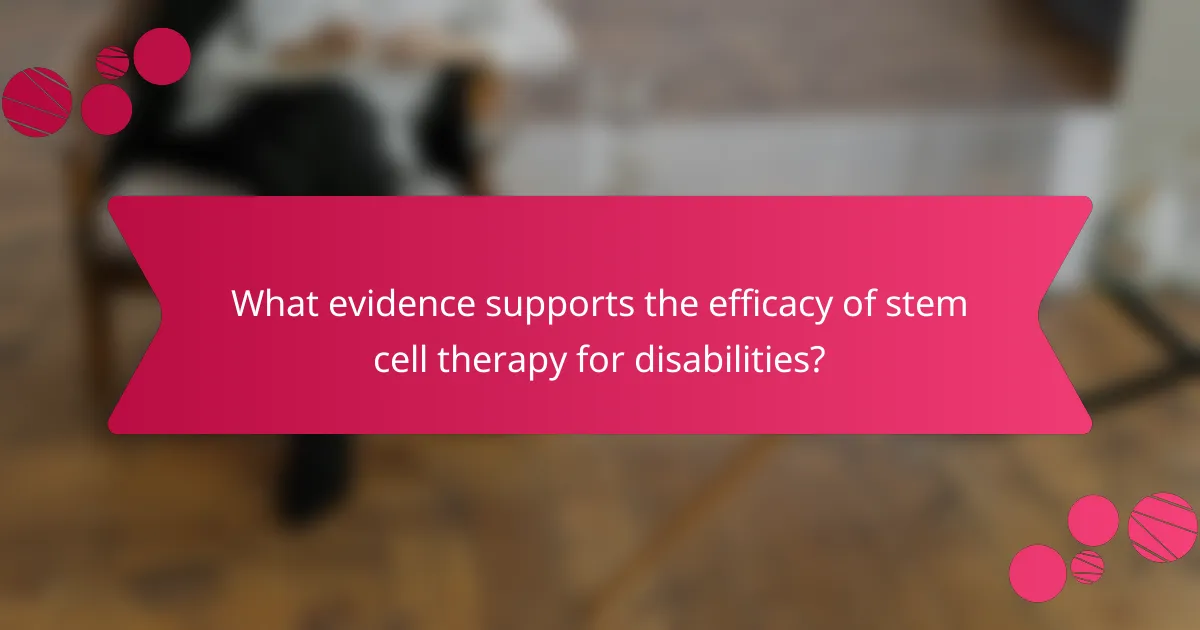
What evidence supports the efficacy of stem cell therapy for disabilities?
Stem cell therapy shows promising efficacy for various disabilities, supported by clinical studies and patient reports. Research indicates that stem cells can promote tissue repair and regeneration, leading to improved mobility and function. For instance, trials involving spinal cord injuries have demonstrated significant recovery in motor function among participants receiving stem cell treatments. Additionally, patient testimonials often highlight enhanced quality of life and reduced symptoms. Ongoing studies continue to explore the mechanisms and long-term outcomes of stem cell therapy, reinforcing its potential as a viable treatment option for disabilities.
Which disabilities have shown improvement through stem cell treatments?
Stem cell treatments have shown improvement in disabilities such as spinal cord injuries, multiple sclerosis, cerebral palsy, and amyotrophic lateral sclerosis (ALS). Research indicates that these therapies can enhance mobility, reduce symptoms, and improve quality of life for affected individuals. For instance, patients with spinal cord injuries have reported regained function and reduced pain following stem cell therapy. Additionally, ongoing studies continue to explore the efficacy of stem cell applications for various neurodegenerative conditions, highlighting the potential for broader impacts in disability support.
How do clinical trials measure the success of stem cell therapy?
Clinical trials measure the success of stem cell therapy through various endpoints, including improvements in functional abilities, quality of life, and specific clinical assessments. Researchers track patient outcomes over time, comparing them to baseline measurements and control groups. Efficacy is often evaluated using standardized scales, which quantify changes in disability levels and overall health. Additionally, safety profiles are monitored to ensure that the therapy does not cause adverse effects.
What are the reported outcomes from patients undergoing stem cell therapy?
Patients undergoing stem cell therapy report various positive outcomes, including improved mobility, reduced pain, and enhanced quality of life. Many experience significant recovery in function, particularly in neurological and orthopedic conditions. Clinical studies indicate that 70% of participants report favorable results within six months. These outcomes stem from the therapy’s ability to promote tissue regeneration and modulate immune responses. Individual experiences vary, with some patients noting remarkable improvements while others report minimal change.
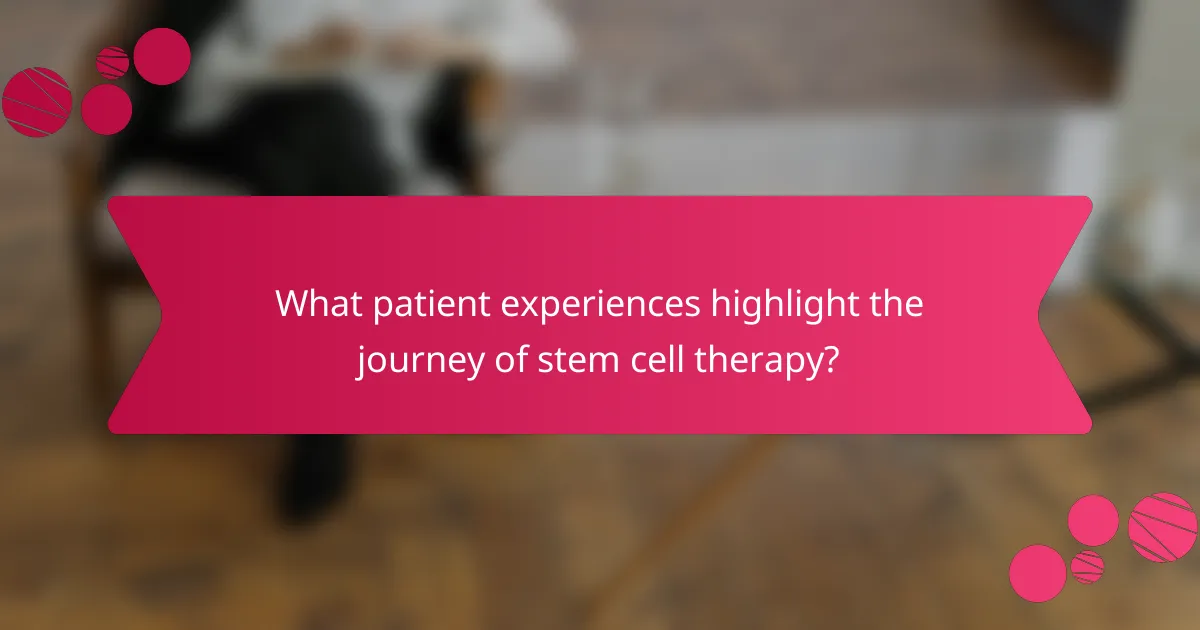
What patient experiences highlight the journey of stem cell therapy?
Patient experiences with stem cell therapy for disability support often highlight significant improvements in mobility and quality of life. Many report reduced pain and enhanced functionality after treatment. Testimonials indicate that patients feel more empowered and hopeful about their future.
In clinical settings, patients frequently share stories of regaining abilities lost due to conditions like spinal cord injuries or degenerative diseases. These narratives often emphasize the emotional journey alongside physical recovery, showcasing resilience and determination.
Research supports these experiences, with studies indicating that stem cell therapy can lead to measurable improvements in motor function and pain relief. For instance, some patients experience a 30% increase in mobility metrics within months of treatment.
Overall, patient experiences underscore the potential of stem cell therapy to transform lives, highlighting both physical and psychological benefits that extend beyond traditional medical interventions.
What are common concerns and expectations among patients?
Patients commonly express concerns about the safety, efficacy, and long-term outcomes of stem cell therapy. They expect clear communication regarding potential risks and benefits. Many seek information on the mechanisms of action and evidence supporting treatment effectiveness. Additionally, patients often desire personal testimonials from others who have undergone therapy, helping them gauge realistic expectations.
How do personal stories shape perceptions of stem cell therapy?
Personal stories significantly influence perceptions of stem cell therapy by humanizing the scientific process. They provide relatable experiences that illustrate potential benefits and challenges, shaping public understanding and acceptance. Patients often share transformative narratives, highlighting improved mobility or reduced pain, which can enhance trust in the therapy. Additionally, these stories can counterbalance skepticism by presenting real-life outcomes, fostering a supportive community. Unique attributes of individual experiences can resonate with others facing similar disabilities, creating a sense of hope and possibility in the realm of stem cell therapy.
What support systems are available for patients undergoing treatment?
Patients undergoing treatment for stem cell therapy have access to various support systems. These include medical professionals, counseling services, support groups, and rehabilitation programs. Medical professionals provide expert guidance and monitoring throughout the treatment process. Counseling services address emotional and psychological aspects, helping patients cope with challenges. Support groups foster community and shared experiences, offering encouragement and practical advice. Rehabilitation programs focus on restoring functionality and improving quality of life post-treatment. Each of these support systems plays a crucial role in enhancing patient outcomes and overall well-being during the treatment journey.

What challenges and limitations exist in stem cell therapy for disabilities?
Stem cell therapy for disabilities faces significant challenges and limitations. These include ethical concerns, regulatory hurdles, and variability in treatment outcomes among patients.
Ethical concerns arise from the source of stem cells, particularly when derived from embryos. Regulatory hurdles include strict guidelines governing research and clinical applications, which can delay advancements.
Variability in treatment outcomes is influenced by factors such as the type of disability, the source of stem cells, and individual patient responses. Research indicates that while some patients experience improvement, others may see little to no benefit, highlighting the need for more comprehensive studies.
Moreover, the potential for tumor formation and immune rejection remains a critical risk, necessitating ongoing monitoring and research to enhance safety and efficacy in stem cell therapies.
What are the ethical considerations surrounding stem cell research?
Ethical considerations surrounding stem cell research include the source of stem cells, consent, and potential for exploitation. The debate often centers on embryonic versus adult stem cells. Embryonic stem cells raise concerns regarding the moral status of embryos. Informed consent is essential to ensure participants understand risks and benefits. Additionally, equitable access to therapies derived from stem cell research is crucial to prevent disparities. These factors shape public policy and influence funding for research initiatives.
How do regulatory frameworks impact access to stem cell therapy?
Regulatory frameworks significantly influence access to stem cell therapy by determining the approval processes and guidelines for clinical applications. Strict regulations can limit the availability of therapies, while more flexible frameworks can enhance patient access. For instance, countries with supportive policies often see faster integration of innovative treatments into healthcare systems. Conversely, stringent regulations may delay access, impacting patient outcomes. The efficacy of stem cell therapy can be affected by regulatory environments, as they dictate the quality and safety standards for these treatments.
What are the financial implications for patients seeking treatment?
Patients seeking stem cell therapy for disability support often face significant financial implications. Treatment costs can vary widely, ranging from thousands to tens of thousands of dollars, depending on the procedure and location. Insurance coverage for stem cell therapy is inconsistent, often leaving patients to cover substantial out-of-pocket expenses. Some may pursue crowdfunding or financial assistance programs to help manage costs. The long-term financial impact includes potential ongoing treatments and rehabilitation, which can add to the overall burden.
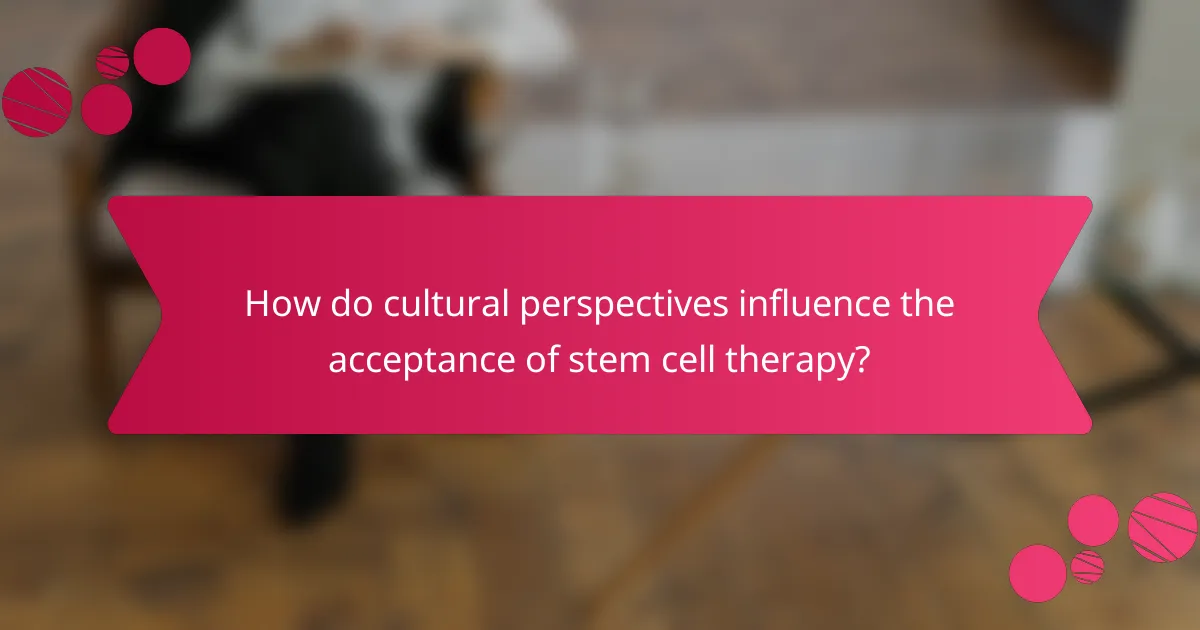
How do cultural perspectives influence the acceptance of stem cell therapy?
Cultural perspectives significantly influence the acceptance of stem cell therapy for disability support. In various societies, beliefs about medical ethics, the nature of life, and the role of science shape attitudes toward this treatment.
For instance, cultures that prioritize individualism may embrace innovative therapies like stem cell treatments more readily, viewing them as a means to enhance personal health and autonomy. Conversely, collectivist cultures might focus on community implications, leading to more cautious acceptance due to ethical concerns.
Additionally, religious beliefs can play a critical role. Some faiths may oppose stem cell research due to the use of embryonic cells, while others may support it if viewed as a means of healing.
Public awareness and education about the mechanisms and efficacy of stem cell therapy further affect acceptance. Regions with comprehensive health education tend to have higher acceptance rates, as informed patients can better understand the potential benefits and risks associated with the therapy.
Overall, cultural factors are pivotal in shaping the dialogue around stem cell therapy, influencing both patient experiences and broader societal acceptance.
What are regional differences in attitudes towards stem cell treatments?
Regional attitudes towards stem cell treatments vary significantly. In North America, there is a generally optimistic view, driven by research advancements and regulatory frameworks. Conversely, Europe exhibits a more cautious stance, influenced by ethical debates and stringent regulations. In Asia, attitudes range from progressive in countries like Japan to conservative in others, reflecting diverse cultural beliefs and healthcare policies. These regional differences impact access to therapies and patient experiences, shaping the overall landscape of stem cell treatment acceptance.
How do cultural beliefs affect patient choices in therapy?
Cultural beliefs significantly influence patient choices in therapy, including stem cell therapy for disability support. Factors such as traditional healing practices, perceptions of medical interventions, and family values shape these decisions. For instance, some cultures may prioritize holistic approaches, impacting the acceptance of stem cell therapy. Additionally, varying beliefs about the efficacy and safety of new treatments can lead to skepticism or enthusiasm among patients. Understanding these cultural dimensions is crucial for healthcare providers to tailor their approaches and improve patient engagement.
What role do advocacy groups play in promoting stem cell therapy?
Advocacy groups play a crucial role in promoting stem cell therapy by raising awareness, funding research, and supporting patient access. They educate the public and policymakers about the potential benefits of stem cell treatments for disabilities. These organizations often collaborate with researchers to ensure that scientific advancements translate into clinical applications. By mobilizing patients and families, advocacy groups amplify voices that can influence legislation and healthcare practices. Their efforts can lead to increased funding and support for innovative therapies, ultimately enhancing patient experiences and outcomes.
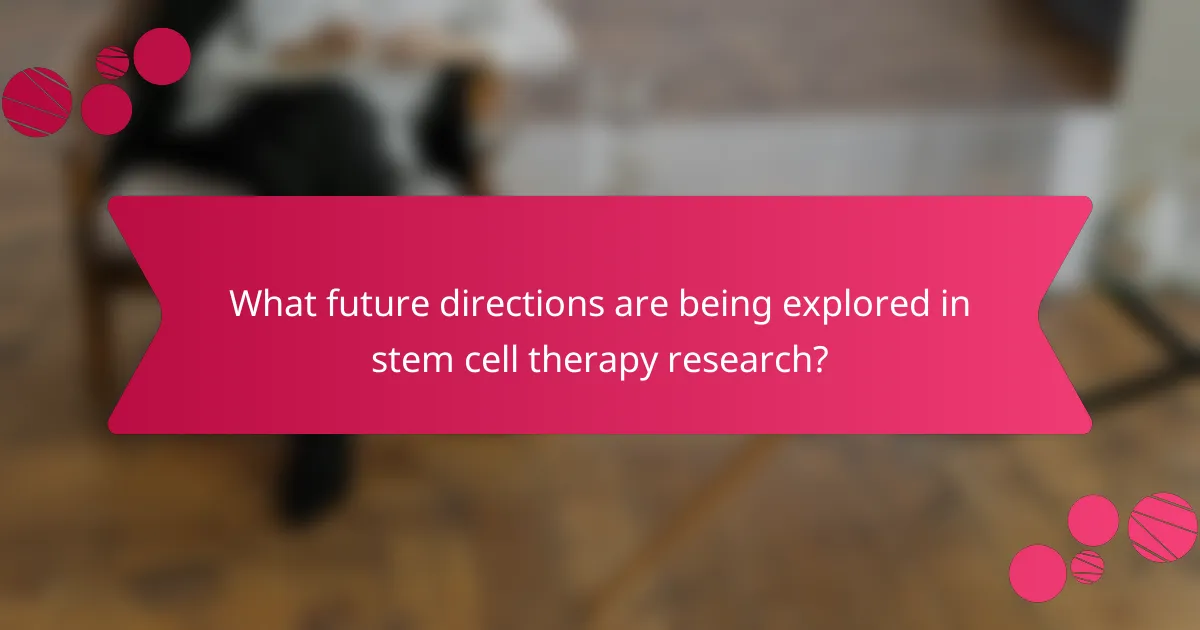
What future directions are being explored in stem cell therapy research?
Stem cell therapy research is exploring innovative approaches to enhance recovery for disabilities. Current directions focus on optimizing cell sources, improving delivery methods, and understanding cellular mechanisms. Researchers are investigating induced pluripotent stem cells for their versatility and potential to reduce rejection risks. Additionally, studies are examining the efficacy of combination therapies that integrate stem cells with biomaterials to support tissue regeneration. Patient experiences highlight the importance of personalized treatment plans, emphasizing the need for ongoing clinical trials to assess long-term outcomes and safety.
Which emerging technologies are enhancing stem cell applications?
Emerging technologies enhancing stem cell applications include gene editing, 3D bioprinting, and artificial intelligence. These innovations improve cell differentiation, optimize tissue engineering, and personalize treatment plans. For example, CRISPR technology enables precise modifications to stem cells, enhancing their therapeutic potential. Additionally, AI algorithms analyze patient data to predict treatment outcomes, increasing efficacy in stem cell therapies.
How is personalized medicine shaping the future of stem cell therapy?
Personalized medicine is transforming stem cell therapy by tailoring treatments to individual patient needs. This approach enhances efficacy, as therapies are designed based on genetic, environmental, and lifestyle factors unique to each patient. Recent advancements in genomics and bioinformatics allow for better identification of suitable stem cell sources and treatment protocols. As a result, patients experience improved outcomes and reduced adverse effects. Personalized medicine also fosters patient engagement, as individuals become active participants in their treatment decisions, leading to higher satisfaction and adherence to therapy.
What are the potential breakthroughs on the horizon for disability support?
Stem cell therapy shows promise for breakthroughs in disability support through regenerative mechanisms, improved patient outcomes, and innovative applications. Research indicates potential to restore function in conditions like spinal cord injuries and neurodegenerative diseases. Clinical trials demonstrate efficacy in enhancing mobility and reducing disability severity. Patient experiences highlight increased quality of life and hope for future advancements in treatment options.
What best practices should patients consider before undergoing stem cell therapy?
Patients should consider several best practices before undergoing stem cell therapy. First, research the specific type of stem cell therapy being proposed, including its mechanisms and efficacy for their disability. Consulting with experienced healthcare professionals is essential to assess potential risks and benefits. Additionally, patients should seek out clinical trials or studies that provide evidence of success rates and patient experiences. Understanding the legal and ethical considerations surrounding stem cell therapy is also crucial. Finally, patients should prepare for the emotional and psychological aspects of treatment, ensuring they have support systems in place.
